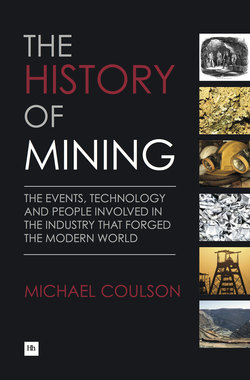Читать книгу The History of Mining - Michael Coulson - Страница 27
На сайте Литреса книга снята с продажи.
11. North America
ОглавлениеThe possibility that the indigenous Indians of North America could have been involved in mining activity is something that early European settlers would have found unlikely given the basic nomadic structure of the lives of these people. However, the discovery of ancient mine workings in the area of Lake Superior in Michigan in the 19th century suggested otherwise, to begin with anyway.
S.O. Knapp, who worked for the Minnesota Mining Company, came across two ancient copper mining sites in Michigan when surveying for the firm. One consisted of an ancient gallery which had been excavated underground and in the gallery were a number of stone hammers and an exposed copper vein. Close by Knapp found evidence of another copper mine where a shaft had been sunk to around 30 feet. In this shaft Knapp came across a large smooth lump of native copper, weighing perhaps 6 tons, which had clearly been worked by miners in the very distant past.
On Isle Royale there are many examples of old mines where pits had been sunk almost 60 feet down to expose the copper vein; these pits extended over a two-mile length. The period of these workings is thought to relate to the 3rd millennium BC and as much as 500,000 tonnes of ore may have been mined, spread over at least 1000 years, although these figures can only be best guesses. Similar ancient copper workings were also unearthed in nearby Wisconsin. In Utah, coal miners at the Lion mine in Wattis found an ancient tunnel system which followed the underground coal seams for several hundred feet. Within this tunnel system there was also a coal ore collection area from where the coal would have been carried to the surface.
Interestingly, in both the cases of Michigan and Utah the indigenous Indians could provide no information from their cultural history of mine working by their ancestors, so Knapp and others had to look elsewhere. It was therefore speculated that these mines were worked by an ancient but technologically advanced people who may have come from as far away as Alaska or indeed Asia and in time continued their journey south across America to Mexico and beyond. No sign has been found of smelting near the ancient Michigan finds, suggesting that whatever was produced was transported – maybe hundreds of miles – to be treated elsewhere and made into copper and possibly bronze items.
In the state of Nevada further evidence has been found of indigenous mining activity in the form of arrowheads and spearheads made from hard rock deposits such as quartz. Spearheads have been found in the Carson Sink in the northwestern part of the state and in the Washoe Valley near Lake Tahoe dating from as far back as the 8th millennium BC. In the 3rd century AD for a couple of hundred years the Anasazi Indians mined turquoise and salt in what is now Clark County, and early prospectors in the 18th and 19th centuries recorded having received assistance from local Indians in locating promising mineral areas.
